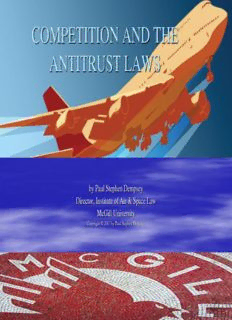
competition and the antitrust laws PDF
Preview competition and the antitrust laws
COMPETITION AND THE ANTITRUST LAWS by Paul Stephen Dempsey Director, Institute of Air & Space Law McGill University Copyright © 2017 by Paul Stephen Dempsey Purposes of the Competition and Antitrust Laws Prohibit collusion between competitors that restrain trade, such as price-fixing. Prohibit monopolization through mergers. Prohibit monopolization through anticompetitive means, such as predation or abuse of a dominant position. US Antitrust Laws Sherman Antitrust Act of 1890 Clayton Act of 1914 Robinson-Patman Act of 1936 Federal Trade Commission Act of 1938 Civil Aeronautics Act of 1938 (Federal Aviation Act of 1958) CONSPIRACIES IN RESTRAINT OF TRADE It is unlawful in many countries around the world for competitors to agree to fix prices or divide territory. In the U.S., such conduct can result in criminal prosecution by the Justice Department, or a civil suit in which treble damages are potentially recoverable. Section 1 of the Sherman Act Prohibits contracts, combinations, and conspiracies in restraint of trade. Per se violations: Price-fixing; territorial allocations; group boycotts; tying arrangements. Airlines seek antitrust immunity to create alliances. NW/KLM granted antitrust immunity in 1993. Jurisprudence Section 1 of the Sherman Act prohibits combinations and conspiracies in restraint of trade. To prevail on a claim that a horizontal agreement among competitors restrains trade, the plaintiff must prove 1. Defendants engaged in a conspiracy; 2. That restrained trade; 3. In the relevant market; and 4. They suffered injury. An aggrieved party must prove the restraint is unreasonable or, in other words, harmful to competition. The purpose of the antitrust laws is to protect competition, not to protect individual competitors. Thus, it is not enough to show that the restraint caused a competitor economic injury. To determine whether the agreement has an adverse effect on competition, courts examine such factors as reduced output, increased prices and decreased quality. Matsushita Elec. Indus v. Zenith Radio Corp., 475 U.S. 574 (1986); Atlantic Richfield Co. v. USA Petroleum Co., 495 U.S. 328, 338 (1990); Virgin Atlantic Airways Ltd. v. British Airways PLC, 257 F.3rd 256, 264 (2nd Cir. 2001). Three Tests The U.S. Supreme Court has identified three methods of assessing whether a horizontal agreement violates Section 1: 1.the per se analysis, for restraints which are obviously anticompetitive like price-fixing, territorial allocations, group boycotts, tying arrangements. 2.quick-look analysis, for restraints with some procompetitive justification; and 3.the rule of reason test, for restraints whose net impact on competition is difficult to determine. California Dental Assn. v. FTC, 526 U.S. 756, 780-81 (1999). See Continental Airlines v. United Airlines, 277 F.3rd 499 (4th Cir. 2002). Article 101 of the EC Treaty Prohibits “all agreements between undertakings … which may affect trade … and which have as their object or effect the prevention, restriction or distortion of competition . . . .” Examples: Price-fixing; Limitation or control of production; Shared markets or sources of supply; Applying dissimilar conditions to equivalent transactions, placing other trading parties at a competitive disadvantage; Making the conclusion of contracts subject to approval by others without commercial justification. In the European Union, companies may face a fine of as much as 10% of annual turnover. The Air Cargo Antitrust Disaster A conspiracy to fix fuel surcharges began in 1996. IATA passed Resolution 116ss on fuel surcharges, but the USDOT denied antitrust immunity. The carriers continued to coordinate fuel surcharges, but since they were not tied to distance flown, they were not correlated with fuel consumption. Fuel prices fell in 2001, but the surcharges continued. In 2006, law enforcement officers raided the offices of several airlines. Twenty airlines and four executives pled guilty and paid fines. Lufthansa turned “state’s evidence”, and entered the corporate leniency program. The Air Cargo Antitrust Disaster Lufthansa, Lan Chile, Air France, British Airlines, Japan Airlines, Korean Airlines, American Airlines, SAS, Asiana Air, Polar Air, Cathay Pacific, Atlas Air, and Cargolux found themselves in the cross- hairs of government antitrust lawyers in a number of countries for fuel and security surcharges. Some airlines paid fines totaling tens of millions of dollars. British Airways and Korean Airlines paid fines of $300 million each in settlement of a U.S. Justice Department investigation. As of 2011, 22 airlines and 21 airline executives were charged in the U.S. Justice Department’s criminal investigation into price fixing. More than $1.8 billion in criminal fines were imposed and four executives were sent to prison. More than 100 civil class action lawsuits were filed by private plaintiffs in the US alone, resulting in settlements of nearly half a billion dollars. By 2012, fines totaled almost $2 billion.
Description: